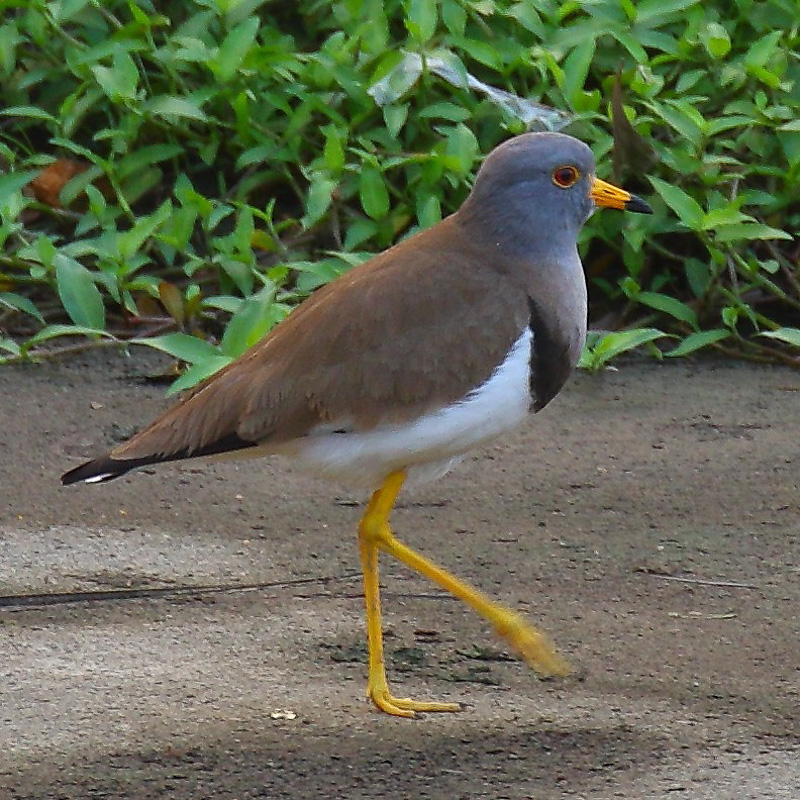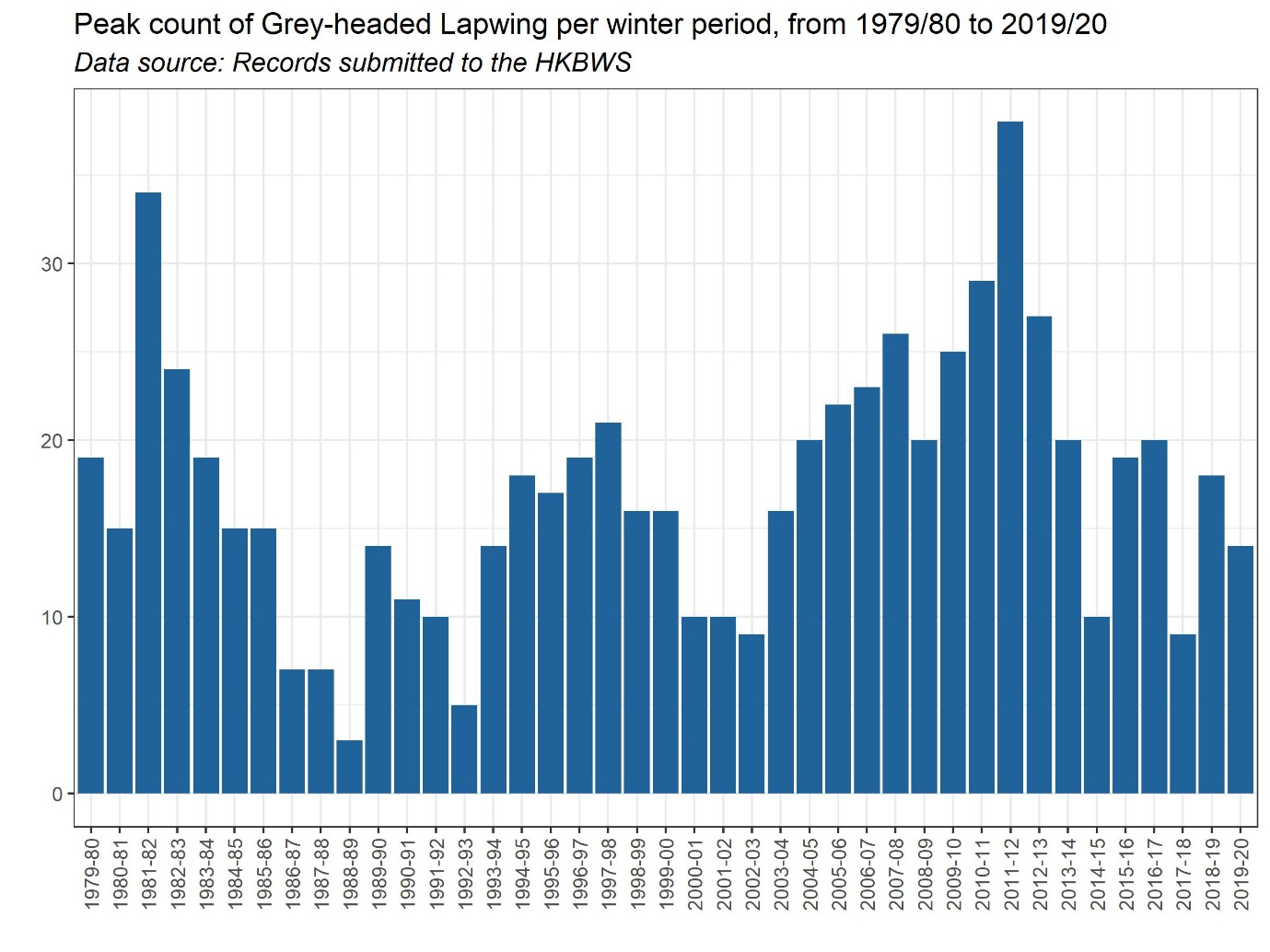Grey-headed Lapwing Vanellus cinereus 灰頭麥雞
Category I. Scarce and localised winter visitor and rare migrant. The wintering flock is largely dependent on one site.
IDENTIFICATION

Apr. 2010, Martin Hale. Adult breeding plumage.
34-37 cm. Large, long-legged plover that looks rather plain at a distance, apart from black-tipped yellow bill and yellow legs. Upperparts cold grey brown, belly to undertail coverts white and tail white with broad subterminal band. The adult has a grey head and chest bordered below by broad blackish band, yellow orbital ring and red eyes.

Oct. 2019, Derek Hon. First-winter.
First-winters are dull brown on the head and upperparts, have pale fringes to the latter feathers, dull legs and bill and a dark eye, and lack a significant breast band early in the winter.

Oct. 2024, Paul Leader. Adult (lower) and first-winter (upper).
In flight a distinctive tri-coloured upperpart pattern of brown, white and black.

Oct. 2022, Paul Leader. First-winter.
The underwing pattern consists of blackish primaries and white secondaries and wing coverts; also has a black tail band that is broad in the centre but narrows to being absent on the outer tail feathers.
VOCALISATIONS
A vocal species that calls readily and loudly when disturbed.
DISTRIBUTION & HABITAT PREFERENCE
The preferred habitat of Grey-headed Lapwing in HK was traditionally areas of grass or vegetable fields in the vicinity of fresh water. However, a reduction in this habitat has meant that the wintering flock has declined to such an extent that since the mid-1990s it has largely been recorded in one area, Kam Tin. Originally birds favoured the so-called buffalo fields, an area of grass grazed by a herd of feral buffalo. After the loss of this area birds utilised the channelised section of Kam Tin River. Previous sites favoured were tidal ponds at Tsim Bei Tsui and a freshwater marsh area at Lo Wu.
In recent years there have been frequent records at Long Valley, especially after part of the area came under the influence of a Management Agreement funded by AFCD and implemented by HKBWS. Most records here have occurred in the final four months of the year, with the highest count being four birds.
Records away from the northwest New Territories are relatively few. These have come from the former airport at Kai Tak (apart from one record of three birds, singles were recorded on spring and autumn passage), the current airport island at Chek Lap Kok (four records of 1-2 birds and a record of nine on 23 February 2016), the Castle Peak coast, Ting Kok/Shuen Wan, Fanling Golf Course, Tai Long Wan, Stanley, Pui O and Po Toi, where migrants have been noted from 5 March to 13 May and on 6 October.
OCCURRENCE
Grey-headed Lapwing is a scarce winter visitor and rare migrant. In years in which over-summering birds were not recorded, the earliest autumn arrivals have occurred on 11 August, in both 2015 and 2019, while the latest spring record occurred on 29 May 2012. The main period of occurrence is from the first week of October to the third week of February, with a gradual departure subsequently (Figure 1). Migrants occur in spring, as the distribution is more widespread than that midwinter.
For a six-year period during 2004-09 there were annual records from the last week of June to the first week of August, with the only other such record during that period occurring in 2020. It is likely that at least some of the July and early August records refer to migrants.
The highest single site counts are considered to be 34 at San Tin on 27 January 1982 and 31 at Kam Tin on 12 November 2011, at which time approximately 38 birds were recorded in the northwest New Territories. In addition, there is a record of 80 at Ha Tsuen on 5 October 1960, though this is exceptionally high given the early autumn date. Numbers have fluctuated since 1980 without any clear long-term pattern of decline or increase (Figure 2).
Grey-headed Lapwing was said by Vaughan and Jones (1913) to be an uncommon bird in southeast China, and they recorded it at Guangzhou and further west. Dove and Goodhart (1955) recorded it only once, and Herklots (1967) mentioned 15 further records up to 1962, primarily in winter though including ‘many small flights’ in the Ping Shan area on 17 October 1962. The latter record recalls the evening of 20 October 1976 when 24 were seen during poor weather at Happy Valley Racecourse.
BEHAVIOUR, FORAGING & DIET
Generally, rather shy and easily disturbed, which is no doubt partly responsible for the decline in numbers over the years as nearby development encroaches on its habitat. The wintering flock is not easily approached and takes flight readily. Has been recorded foraging nocturnally on golf course grass.
RANGE & SYSTEMATICS
Monotypic. In China breeds from central northeast areas south through Hebei to widespread areas south of the Yellow River as far as the southern edge of the Yangtze floodplain and Taiwan, and west to the lower parts of the Qinghai Tibetan plateau; winters in southwest and southern coastal provinces, including Hainan (Liu and Chen 2020). Some birds breed in Far East Russia and Japan, and the wintering range includes southern Japan, and extends to much of Indochina and west to northern India (Wiersma and Kirwan 2020).
CONSERVATION STATUS
IUCN: Least Concern. Population trend decreasing.
Figure 1.

Figure 2.

Dove, R. S. and H. J. Goodhart (1955). Field observations from the Colony of Hong Kong. Ibis 97: 311-340.
Herklots, G. A. C. 1967. Hong Kong Birds (2nd ed.). South China Morning Post, Hong Kong.
Liu, Y. and Y. H. Chen (eds) (2020). The CNG Field Guide to the Birds of China (in Chinese). Hunan Science and Technology Publication House, Changsha.
Vaughan, R. E. and K. H. Jones (1913). The birds of Hong Kong, Macao and the West River or Si Kiang in South-East China, with special reference to their nidification and seasonal movements. Ibis 1913: 17-76, 163-201, 351-384.
Wiersma, P. and G. M. Kirwan (2020). Grey-headed Lapwing (Vanellus cinereus), version 1.0. In Birds of the World (J. del Hoyo, A. Elliott, J. Sargatal, D. A. Christie, and E. de Juana, Editors). Cornell Lab of Ornithology, Ithaca, NY, USA. https://doi.org/10.2173/bow.gyhlap1.01

